- Home
- Garden Wildlife
- Insects
- True flies
- Hoverflies
Hoverflies
Hoverflies belong to the Syrphidae family of flies and are often seen hovering in flight. They are 4-16mm in length. Many species are black with yellow bands or other markings on the abdomen and thorax, mimicking dangerous wasps and bees, but some have drab colours, being almost entirely black or brown. A feature of hoverfly wings is the presence of a false vein or vena spuria across most of the length of the wing in the central area. This false vein is less distinct than a real vein and is created by a crease in the wing.
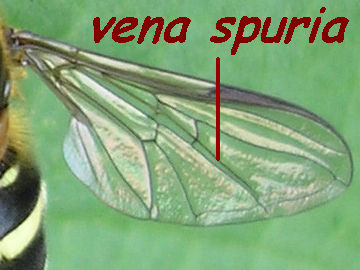
Species in Britain and Ireland
There are more than 280 species of hoverfly in Britain and Ireland and many species come into gardens as adults to feed on nectar and pollen. Because they are large, easily seen, harmless and beneficial, hoverflies are more popular and better documented than most groups of flies. Gardens also provide places where hoverfly larvae can develop, especially of those species with aphid-eating larvae. Jennifer Owen recorded 94 species in her study, all caught using a malaise trap. They are skilful fliers and hard to catch with a net.
Biology
Hoverfly larvae have a variety of feeding habits. They are often regarded as all having aphid-eating larvae, but in fact less than half the species found in Britain and Ireland have predatory larvae. The many larval habitats and feeding choices of this group are outlined below.
Species with predatory larvae – many feeding on aphids but some species prefer psyllids (plant suckers), adelgids or caterpillars. Species include those in the genera Chrysotoxum (3spp) , Dasysyrphus (4spp), Epistrophe (3spp), Episyrphus (1 sp) , Eupeodes (4 spp), Heringia (1sp), Leucozona (1sp), Melangyna (3spp), Melanostoma (2spp), Meliscaeva (2spp), Parasyrphus (2spp), Pipiza (5spp), Pipizella (1sp), Platycheirus (9spp) Scaeva (2spp), Sphaerophoria (3spp) and Syrphus (3spp). The number of species refers to Jennifer Owen's garden records.
Species with larvae in compost heaps and tree rot holes – common species seen in gardens with larvae that feed in decaying plant material include Neoascia podagrica, Xylota segnis, Syritta pipiens and Myathropa florea, all of which were found by Jennifer Owen.
Decaying material hoverflies Left: Hoverfly Neoascia podagrica Right: Hoverfly Syritta pipiens
Species with larvae in pond margins and pools of water – Eristalis species, also known as drone flies because of their resemblance to male honeybees, develop in water that has been enriched by excrement or rotting plant material. The larvae have long thin tails that they can extend up to the water surface to take in air, and are commonly known as rat-tailed maggots. Jennifer Owen recorded 7 species of Eristalis, with E. arbustorum most comon. Other hoverflies associated with pond margins are Helophilus pendulus, Chrysogaster species and Melanogaster species
Species with larvae eating fungi three Cheilosia species including the dark-horned truffle-cheilosia Cheilosia scutellata and the red-horned truffle-cheilosia Cheilosia soror develop as larvae in the fruiting bodies of some fungi. Truffle flies (not all syrphids) are watched by truffle-hunters to locate where to dig.
Dark-horned truffle-cheilosia Cheilosia scutellata and the red-horned truffle-cheilosia Cheilosia soror
Species with larvae in bumblebee and wasp nests The larvae of Volucella bombylans feed as scavengers in bumblebee nests. Those of the hornet-mimic hoverfly Volucella zonaria, V. pellucens and V.inanis feed in wasp nests.
Volucella bombylans is a consummate bumblebee mimic, and even has two colour forms. Volucella bombylans var. plumata (left image) has a white tail, mimicking the white-tailed bumblebee Bombus lucorum and the buff-tailed bumblebee Bombus terrestris. Volucella bombylans var. bombylans (centre image) has an orange-red tail, mimicking the red-tailed bumblebee Bombus lapidarius. The right image is the hornet-mimic hoverfly Volucella zonaria.
Life cycle
Hoverflies lay their eggs during spring-summer. These hatch and the larvae feed on their particular food materials as indicated above. When fully fed, the larvae pupate, with those living as larvae in wet situations often moving to dryer places before pupating. Most hoverflies have one generation a year but some have two. Hoverflies overwinter as larvae, pupae or in some species as adults.
Role of hoverflies in gardens
Hoverflies are generally beneficial insects as many have larvae that help to reduce aphid numbers, others help recycle decomposing organic matter. Flower visiting by the adult flies means that hoverflies are also useful as pollinating insects. The Syrphidae does have two species that damage garden plants, narcissus and house leeks, but then most families have at least one reprobate.
Encouraging hoverflies in gardens
Adult hoverflies visit flowers to feed on pollen and nectar. Most species have short mouthparts, so they use flowers where pollen and nectar is easily accessible, such as flowers of the daisy type. They also feed on the sugary honeydew excreted by aphids. Judith Webb's paper listed below is an excellent source of information'
As with other pollinators, avoid double flowers. You need flowers that open in hoverfly flight periods, which are generally May, then again from late July to early autumn. They prefer open flat flower heads to land on, preferably with many flowers, such as the Apiaceae (previously called umbellifers) which includes hogweed, fennel, cow parsely and ground elder. Other good plants are species of Eupatorium (including hemp agrimony Eupatorium cannabinum), oxeye daisy Leucanthemum spp, and buttercups Ranunculus spp.
Among shrubs, privet and elder are excellent, and the spindles Euonymus spp. The best trees, are lime Tilia spp. and sycamore Acer pseudoplatanus which are good because of the honeydew they produce. The best climber, as for so many other garden creatures, is ivy Hedera spp.
Finally it's worth noting that for pollen feeding, some wind pollinated plants such as grasses, hazel and oak offer very rich pickings for hoverflies.
Other sources of information
Websites
Website of the UK hoverfly recording scheme
Steve Falk’s images and information on hoverflies
Judith Webb's paper "Flowers for flies" (special article near end)
Books
Ball, S. & Morris, R. (2015) Britain's Hoverflies: A Field Guide, Revised and Updated Second Edition. WILDGuides
Stubbs, A. & Falk, S. J. (2002) British hoverflies. British Entomological and Natural History Society
Page text drafted by Andrew Halstead, reviewed by Andrew Salisbury, compiled by Steve Head
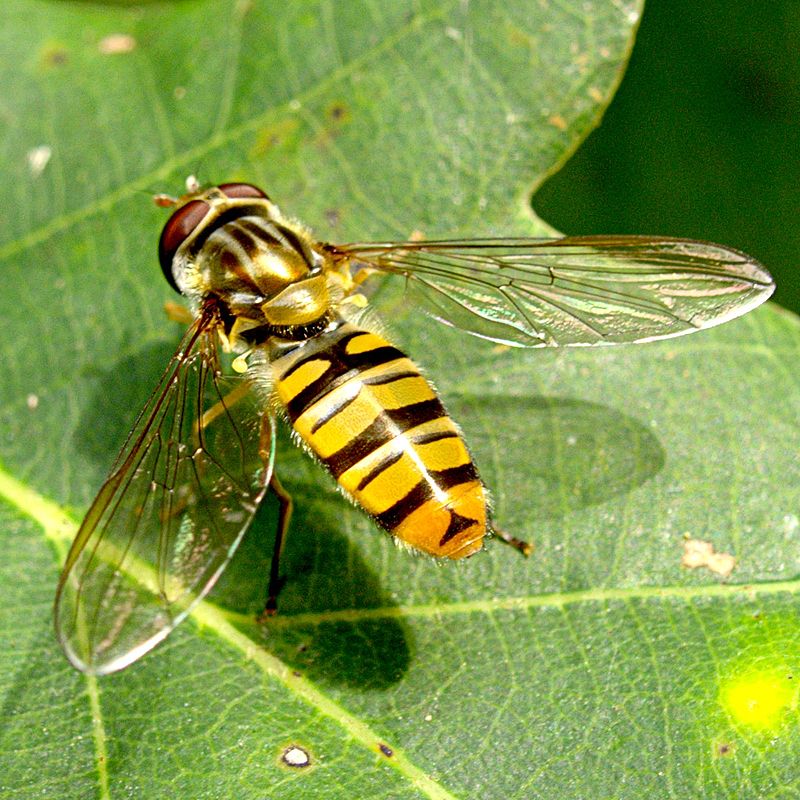
.jpg)
.jpg)
![Hover fly Syrphus ribesii Photo: by Alvesgaspar [CC BY-SA 3.0 (https://creativecommons.org/licenses/by-sa/3.0)]](images/1280px-Hoverfly_December_2007-4.jpg)
Common aphid-eating hoverflies. Left: marmalade hoverfly Episyrphus balteatus - the most abundant in Jennifer Owen's garden Centre: Melanostoma mellinum Right: Platycheirus albimanus
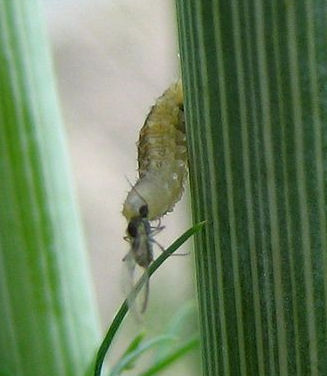
![Hoverfly larva Photo: gailhampshire from Cradley, Malvern, U.K [CC BY 2.0 (https://creativecommons.org/licenses/by/2.0)]](images/1024px-Hoverfly_larva._-_Flickr_-_gailhampshire.jpg)
Left: hover fly Syrphus ribesii adult Centre: hoverfly larva Right: hoverfly larva eating an aphid
Species with plant-feeding larvae - Cheilosia caerulescens mines the leaves of house leeks, see our page on leaf-mining flies here. The large narcissus bulb fly, Merodon equestris is a damaging pest of narcissus bulbs. Eumerus species, known as small bulb flies, feed inside narcissus bulbs that have previously been damaged by another pest or disease. Eumerus tuberculatus and E. strigatus were common in Jennifer Owen's garden.
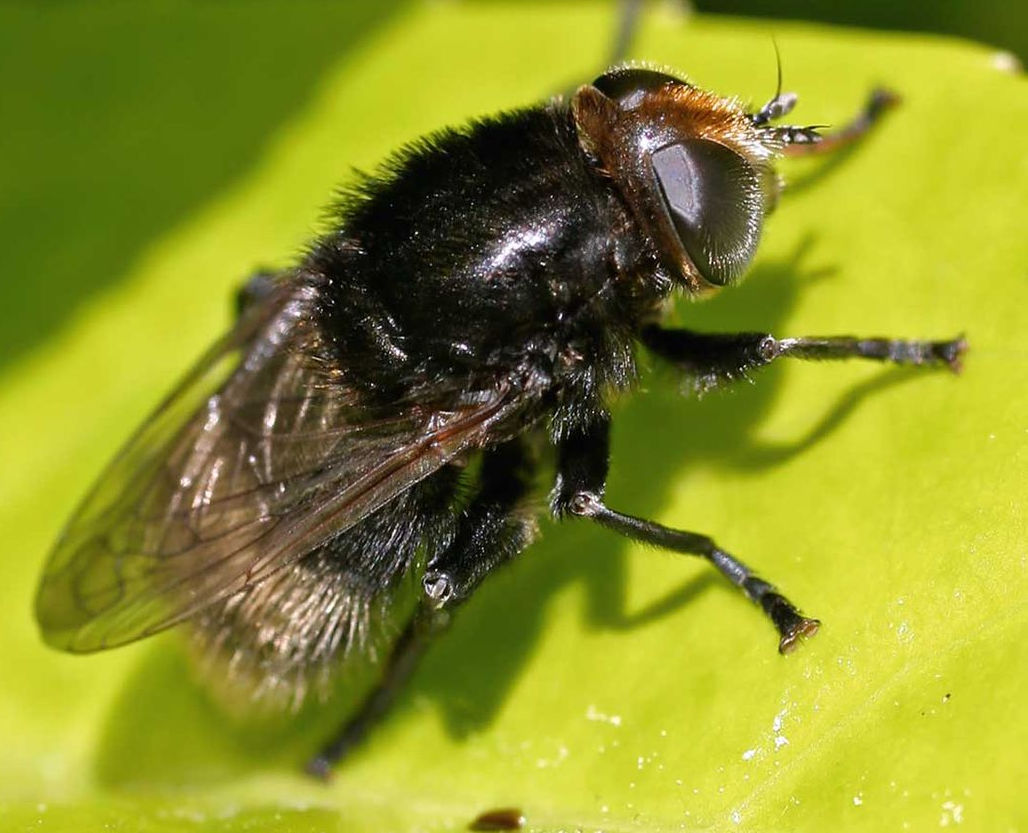
Narcissus bulb fly Merodon equestris This large (15mm) hoverfly is a bumblebee mimic.
_-_Flickr_-_S._Rae_(2).jpg)
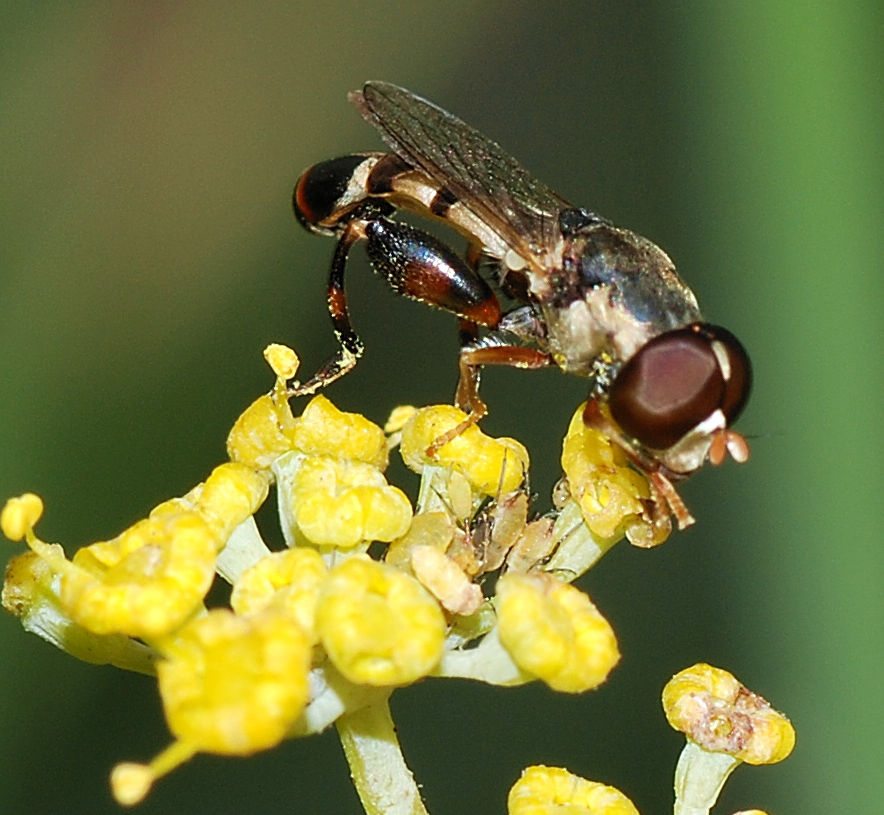
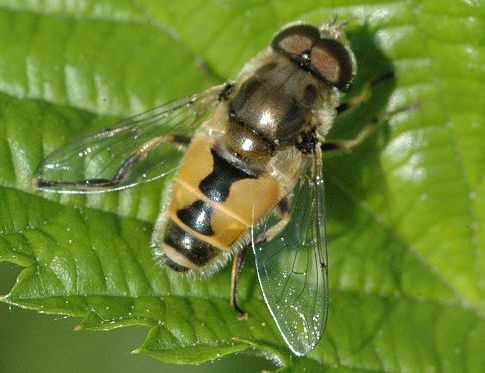
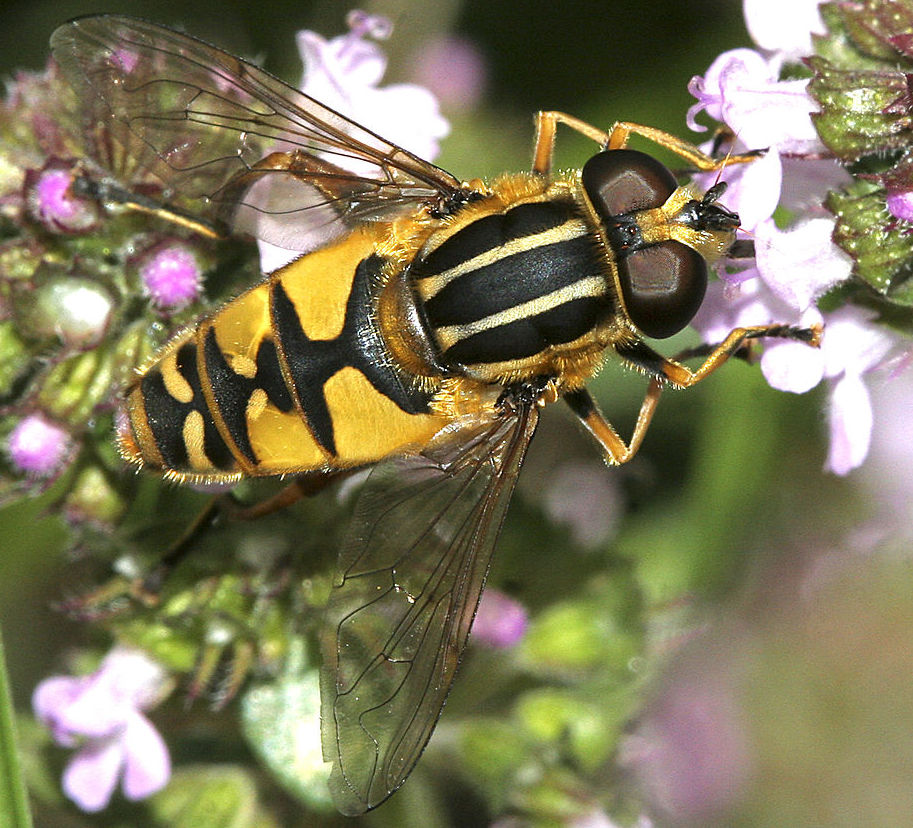
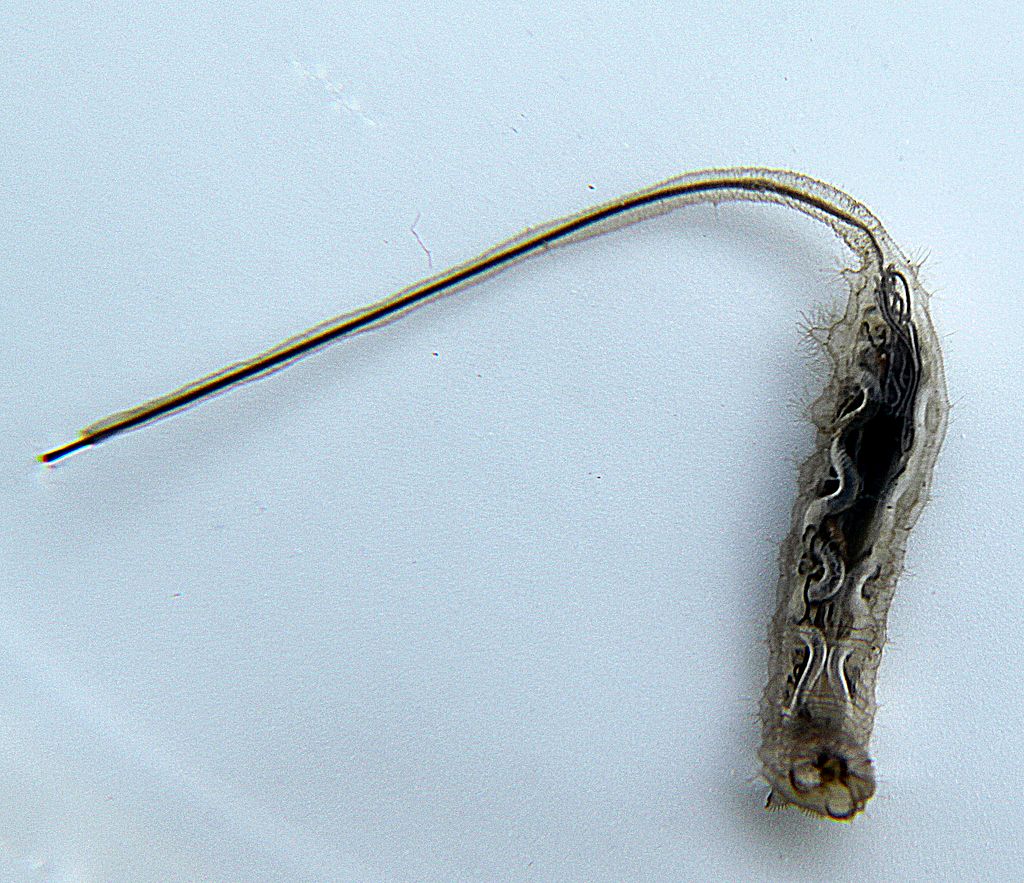
Aquatic hoverflies. Above left: Eristalis arbustorum Above right: Helophilus pendulus
Left: Rat-tailed larva Eristalis sp. These larvae have a long telescopic breathing tube arising from the posterior end of the larva. The tube is normally about 20mm long, but can extend to over 100mm. This alows the larvae to live in really stagnant, oxygen-depleted water (including sewage), that other freshwater insects can't cope with. Such water of course will contain a lot of dissolved and suspended food particles for the larvae to eat.
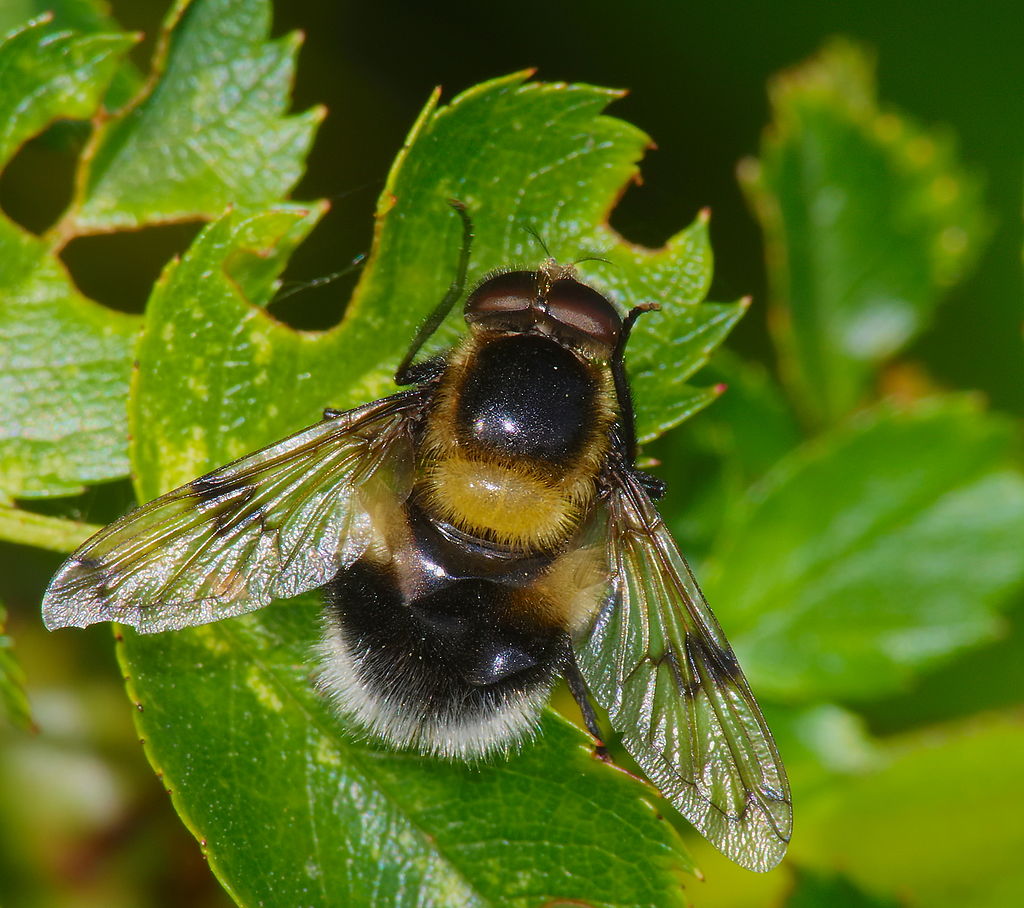
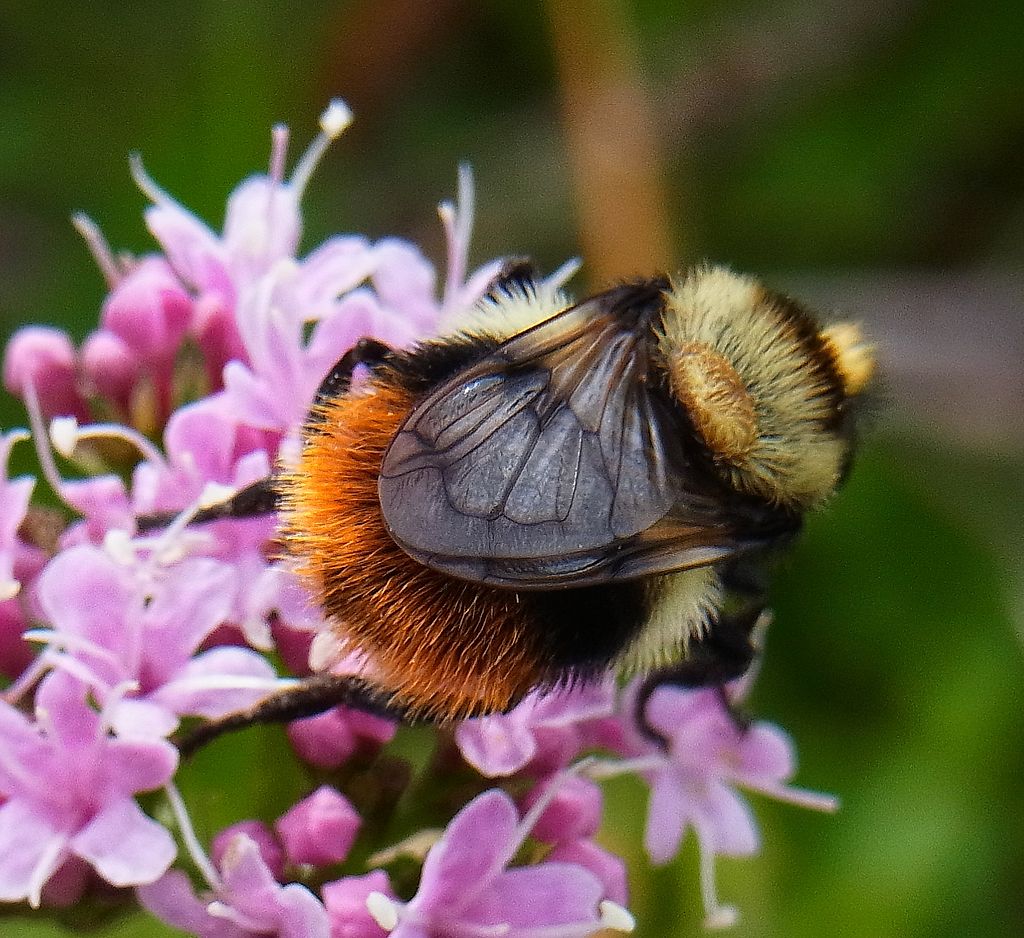
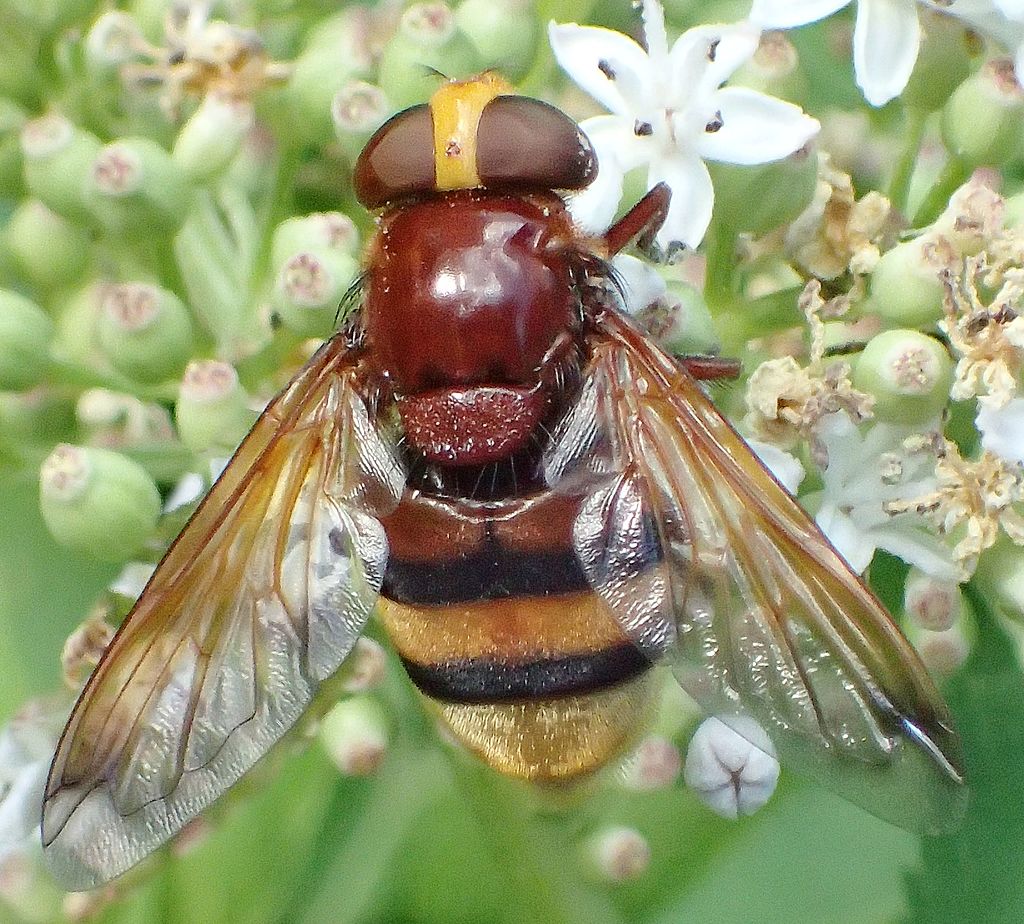
Hoverflies
Hoverflies belong to the Syrphidae family of flies and are often seen hovering in flight. They are 4-16mm in length. Many species are black with yellow bands or other markings on the abdomen and thorax, mimicking dangerous wasps and bees, but some have drab colours, being almost entirely black or brown. A feature of hoverfly wings is the presence of a false vein or vena spuria across most of the length of the wing in the central area. This false vein is less distinct than a real vein and is created by a crease in the wing.

Species in Britain and Ireland
There are more than 280 species of hoverfly in Britain and Ireland and many species come into gardens as adults to feed on nectar and pollen. Because they are large, easily seen, harmless and beneficial, hoverflies are more popular and better documented than most groups of flies. Gardens also provide places where hoverfly larvae can develop, especially of those species with aphid-eating larvae. Jennifer Owen recorded 94 species in her study, all caught using a malaise trap. They are skilful fliers and hard to catch with a net.
Biology
Hoverfly larvae have a variety of feeding habits. They are often regarded as all having aphid-eating larvae, but in fact less than half the species found in Britain and Ireland have predatory larvae. The many larval habitats and feeding choices of this group are outlined below.
Species with predatory larvae – many feeding on aphids but some species prefer psyllids (plant suckers), adelgids or caterpillars. Species include those in the genera Chrysotoxum (3spp) , Dasysyrphus (4spp), Epistrophe (3spp), Episyrphus (1 sp) , Eupeodes (4 spp), Heringia (1sp), Leucozona (1sp), Melangyna (3spp), Melanostoma (2spp), Meliscaeva (2spp), Parasyrphus (2spp) , Pipiza (5spp), Pipizella (1sp), Platycheirus (9spp) Scaeva (2spp), Sphaerophoria (3spp) and Syrphus (3spp). The number of species refers to Jennifer Owen's garden records.

.jpg)
.jpg)
Common aphid-eating hoverflies. Left: Platycheirus albimanus Right:Syrphus ribesii
Common aphid-eating hoverflies. Left: marmalade hoverfly Episyrphus balteatus - the most abundant in Jennifer Owen's garden Right: Melanostoma mellinum
![Hover fly Syrphus ribesii Photo: by Alvesgaspar [CC BY-SA 3.0 (https://creativecommons.org/licenses/by-sa/3.0)]](images/1280px-Hoverfly_December_2007-4.jpg)
Hoverfly larva Right: hoverfly larva eating an aphid
Species with plant-feeding larvae - Cheilosia caerulescens mines the leaves of house leeks, see our page on leaf-mining flies here. The large narcissus bulb fly, Merodon equestris is a damaging pest of narcissus bulbs. Eumerus species, known as small bulb flies, feed inside narcissus bulbs that have previously been damaged by another pest or disease. Eumerus tuberculatus and E. strigatus were common in Jennifer Owen's garden.
![Hoverfly larva Photo: gailhampshire from Cradley, Malvern, U.K [CC BY 2.0 (https://creativecommons.org/licenses/by/2.0)]](images/1024px-Hoverfly_larva._-_Flickr_-_gailhampshire.jpg)


Narcissus bulb fly Merodon equestris This large (15mm) hoverfly is a bumblebee mimic.
Species with larvae in compost heaps and tree rot holes – common species seen in gardens with larvae that feed in decaying plant material include Neoascia podagrica, Xylota segnis, Syritta pipiens and Myathropa florea, all of which were found by Jennifer Owen.

_-_Flickr_-_S._Rae_(2).jpg)
Decaying material hoverflies Left: Hoverfly Neoascia podagrica Right: Hoverfly Syritta pipiens
Species with larvae in pond margins and pools of water – Eristalis species, also known as drone flies because of their resemblance to male honeybees, develop in water that has been enriched by excrement or rotting plant material. The larvae have long thin tails that they can extend up to the water surface to take in air, and are commonly known as rat-tailed maggots. Jennifer Owen recorded 7 species of Eristalis, with E. arbustorum most comon. Other hoverflies associated with pond margins are Helophilus pendulus, Chrysogaster species and Melanogaster species



Aquatic hoverflies. Above left: Eristalis arbustorum Above right: Helophilus pendulus
Left: Rat-tailed larva Eristalis sp. These larvae have a long telescopic breathing tube arising from the posterior end of the larva. The tube is normally about 20mm long, but can extend to over 100mm. This alows the larvae to live in really stagnant, oxygen-depleted water (including sewage), that other freshwater insects can't cope with. Such water of course will contain a lot of dissolved and suspended food particles for the larvae to eat.
_-_female_-_Flickr_-_S._Rae_(4).jpg)
.jpg)
Species with larvae eating fungi three Cheilosia species including the dark-horned truffle-cheilosia Cheilosia scutellata and the red-horned truffle-cheilosia Cheilosia soror develop as larvae in the fruiting bodies of some fungi. Truffle flies (not all syrphids) are watched by truffle-hunters to locate where to dig.
Dark-horned truffle-cheilosia Cheilosia scutellata and the red-horned truffle-cheilosia Cheilosia soror
Species with larvae in bumblebee and wasp nests The larvae of Volucella bombylans feed as scavengers in bumblebee nests. Those of the hornet-mimic hoverfly Volucella zonaria, V. pellucens and V.inanis feed in wasp nests.
_-_female_-_Flickr_-_S._Rae_(4).jpg)
.jpg)
Life cycle
Hoverflies lay their eggs during spring-summer. These hatch and the larvae feed on their particular food materials as indicated above. When fully fed, the larvae pupate, with those living as larvae in wet situations often moving to dryer places before pupating. Most hoverflies have one generation a year but some have two. Hoverflies overwinter as larvae, pupae or in some species as adults.
Role of hoverflies in gardens
Hoverflies are generally beneficial insects as many have larvae that help to reduce aphid numbers, others help recycle decomposing organic matter. Flower visiting by the adult flies means that hoverflies are also useful as pollinating insects. The Syrphidae does have two species that damage garden plants, narcissus and house leeks, but then most families have at least one reprobate.
Encouraging hoverflies in gardens
Adult hoverflies visit flowers to feed on pollen and nectar. Most species have short mouthparts, so they use flowers where pollen and nectar is easily accessible, such as flowers of the daisy type. They also feed on the sugary honeydew excreted by aphids. Judith Webb's paper listed below is an excellent source of information'
As with other pollinators, avoid double flowers. You need flowers that open in hoverfly flight periods, which are generally May, then again from late July to early autumn. They prefer open flat flower heads to land on, preferably with many flowers, such as the Apiaceae (previously called umbellifers) which includes hogweed, fennel, cow parsely and ground elder. Other good plants are species of Eupatorium (including hemp agrimony Eupatorium cannabinum), oxeye daisy Leucanthemum spp, and buttercups Ranunculus spp.
Among shrubs, privet and elder are excellent, and the spindles Euonymus spp. The best trees, are lime Tilia spp. and sycamore Acer pseudoplatanus which are good because of the honeydew they produce. The best climber, as for so many other garden creatures, is ivy Hedera spp.
Finally it's worth noting that for pollen feeding, some wind pollinated plants such as grasses, hazel and oak offer very rich pickings for hoverflies.
Other sources of information
Websites
Website of the UK hoverfly recording scheme
Books
Ball, S. & Morris, R. (2015) Britain's Hoverflies: A Field Guide, Revised and Updated Second Edition. WILDGuides
Stubbs, A. & Falk, S. J. (2002) British hoverflies. British Entomological and Natural History Society
Page text drafted by Andrew Halstead, reviewed by Andrew Salisbury, compiled by Steve Head



Volucella bombylans is a consummate bumblebee mimic, and even has two colour forms. Volucella bombylans var. plumata (left image) has a white tail, mimicking the white-tailed bumblebee Bombus lucorum and the buff-tailed bumblebee Bombus terrestris. Volucella bombylans var. bombylans (right image) has an orange-red tail, mimicking the red-tailed bumblebee Bombus lapidarius.
Hornet-mimic hoverfly Volucella zonaria.












